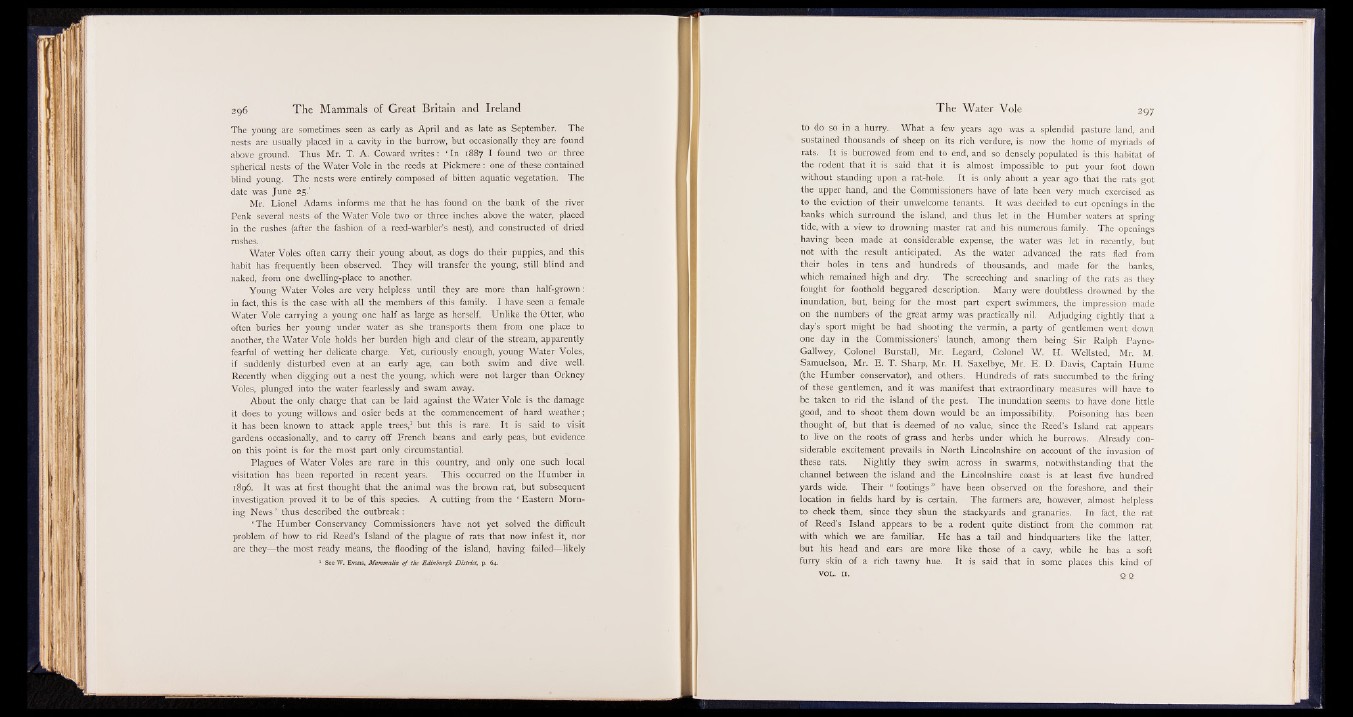
296
The young are sometimes seen as early as April and as late as September. The
nests are usually placed in a cavity in the burrow, but occasionally they are found
above ground. Thus Mr. T. A. Coward writes: ‘ In 1887 I found two or three
spherical nests of the Water Vole in the reeds at Pickmere: one of these contained
blind young. The nests were entirely composed of bitten aquatic vegetation. The
date was June 25.’
Mr. Lionel Adams informs me that he has found on the bank of the river
Penk several nests of the Water Vole two or three inches above the water, placed
in the rushes (after the fashion of a reed-warbler’s nest), and constructed of dried
rushes.
Water Voles often carry their young about, as dogs do their puppies, and this
habit has frequently been observed. They will transfer the young, still blind and
naked, from one dwelling-place to another.
Young Water Voles are very helpless until they are more than half-grown:
in fact, this is the case with all the members of this family. I have seen a female
Water Vole carrying a young one half as large as herself. Unlike the Otter, who
often buries her young under water as she transports them from one place to
another, the Water Vole holds her burden high and clear of the stream, apparently
fearful of wetting her delicate charge. Yet, curiously enough, young Water Voles,
if suddenly disturbed even at an early age, can both swim and dive well.
Recently when digging out a nest the young, which were not larger than Orkney
Voles, plunged into the water fearlessly and swam away.
About the only charge that can be laid against the Water Vole is the damage
it does to young willows and osier beds at the commencement of hard weather;
it has been known to attack apple trees,1 but this is rare. It is said to visit
gardens occasionally, and to carry off French beans and early peas, but evidence
on this point is for the most part only circumstantial.
Plagues of Water Voles are rare in this country, and only one such local
visitation has been reported in recent years. This occurred on the Humber in
1896. It was at first thought that the animal was the brown rat, but subsequent
investigation proved it to be of this species. A cutting from the ‘ Eastern Morning
News ’ thus described the outbreak:
‘ The Humber Conservancy Commissioners have not yet solved the difficult
problem of how to rid Reed’s Island of the plague of rats that now infest it, nor
are they—the most ready means, the flooding of the island, having failed—likely
1 See W. Evans, Mammalia of the Edinburgh District, p. 64.
to do so in a hurry. What a few years ago was a splendid pasture land, and
sustained thousands of sheep on its rich verdure, is now the home of myriads of
rats. It is burrowed from end to end, and so densely populated is this habitat of
the rodent that it is said that it is almost impossible to put your foot down
without standing upon a rat-hole. It is only about a year ago that the rats got
the upper hand, and the Commissioners have of late been very much exercised as
to the eviction of their unwelcome tenants. It was decided to cut openings in the
banks which surround the island, and thus let in the Humber waters at spring
tide, with a view to drowning master rat and his numerous family. The openings
having been made at considerable expense, the water was let in recently, but
not with the result anticipated. As the water advanced the rats fled from
their holes in tens and hundreds of thousands, and made for the banks,
which remained high and dry. The screeching and snarling of the rats as they
fought for foothold beggared description. Many were doubtless drowned by the
inundation, but, being for the most' part expert swimmers, the impression made
on the numbers of the great army was practically nil. Adjudging rightly that a
day’s sport might be had shooting the vermin, a party of gentlemen went down
one day in the Commissioners’ launch, among them being Sir Ralph Payne-
Gallwey, Colonel Burstall, Mr, Legard, Colonel W. H. Wellsted, Mr. M.
Samuelson, Mr. E . T. Sharp, Mr. H. Saxelbye, Mr. E . D. Davis, Captain Hume
(the Humber conservator), and others. Hundreds of rats succumbed to the firing
of these gentlemen, and it was manifest that extraordinary measures will have to
be taken to rid the island of the pest. The inundation seems to have done little
good, and to shoot them down would be an impossibility. Poisoning has been
thought of, but that is deemed of no value, since the Reed’s Island rat appears
to live on the roots of grass and herbs under which he burrows. Already considerable
excitement prevails in North Lincolnshire on account of the invasion of
these rats. Nightly they swim across in swarms, notwithstanding that the
channel between the island and the Lincolnshire coast is at least five hundred
yards wide. Their “ footings ” have been observed on the foreshore, and their
location in fields hard by is certain. The farmers are, however, almost helpless
to check them, since they shun the stackyards and granaries. In fact, the rat
of Reed’s Island appears to be a rodent quite distinct from the common rat
with which we are familiar. He has a tail and hindquarters like the latter,
but his head and ears are more like those of a cavy, while he has a soft
furry skin of a rich tawny hue. It is said that in some places this kind of
VOL. II. Q Q